BATMAN: THE MOVIE AND THE COMICS
It seems like the writing staff of the 1960s Batman TV show were pretty well versed in their comic lore. They regularly consulted the comics for inspiration and adapted many stories directly from the source material. Batman co-creator Bill Finger even contributed a few scripts for the series. But what we’re looking at here is the 1966 feature film and the comics that may have influenced it.
Let’s start with a word about casting. Over the years many people have poked fun at Adam West’s physique, suggesting he was extremely out of shape when he played Batman. In reality though, West was much more athletic than many gave him credit for. His press bio, released by 20th Century Fox when the show started, contained the following statement:
"He is personable, tall, with an athlete's physique, a warm voice, expressive green eyes and a conversational style very much his own."
Photographs of West taken at the time seem to verify this, showing him to have a slim athletic build not unlike the one Batman had in the comics at the time. Add to this the fact that he’s the only Batman actor to date to match Batman’s 6’2 height in the comics, and it’s fair to say West was an adequate physical match for the part.
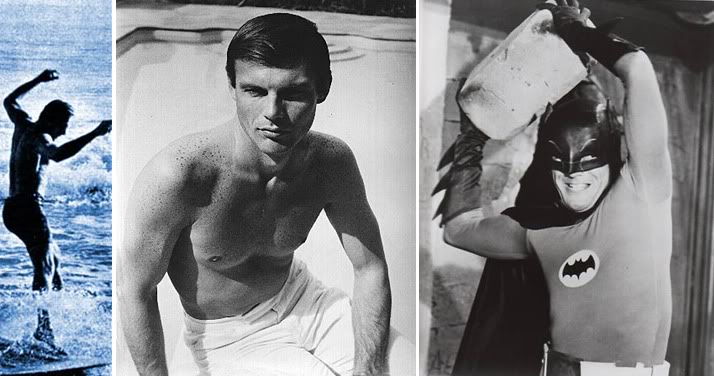
Another criticism contemporary viewers sometimes level at West’s performance is the fact he didn’t change his voice when playing Batman. It’s true that modern comics describe Batman as speaking in a low, cold whisper. But in the Pre-Crisis comics he was described as sounding ‘calm’ and ‘masterful’ – which is pretty much exactly how West’s Batman sounded.
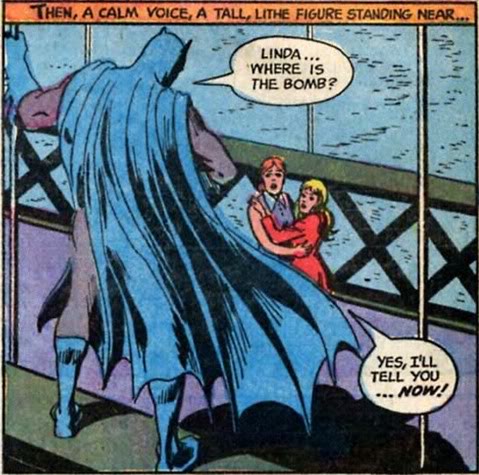
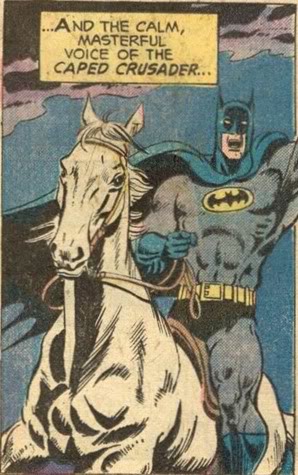
Both Batman and Robin’s costumes are more or less identical to the comic versions. Batman’s costume is based on the Silver Age Earth-One version that was contemporary at the time of the film’s production. The Earth-One Batman’s costume is easily distinguishable from the Earth-Two’s on account of the yellow oval surrounding the chest emblem.
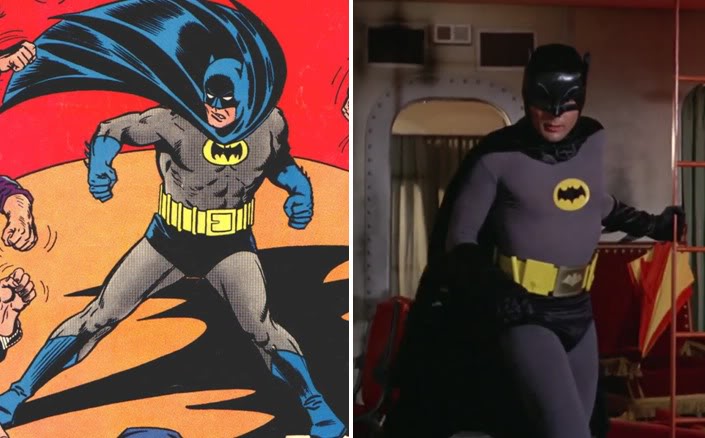
As for Burt Ward, he was obviously older than the Robin in the comics. But his youthful features allowed him to pass for a teenager. And like Dick Grayson, Ward had a background in athletics. At the age of two he became the world’s youngest professional ice skater. He continued pursuing athletic endeavours, such as football and wrestling, during his high school years. And he also cultivated an interest in martial arts, earning a black belt in Taekwondo that helped him convince the producers of the TV show he was right for the role. Standing next to his 6’2 co-star, the 5’8 Ward certainly looked like the Robin from the comics. His costume matched the comic version perfectly too.
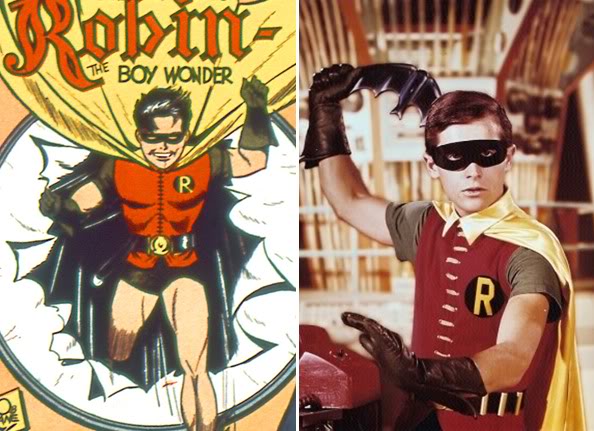
In both the movie and the TV show, Robin is heard to spout his famous "Holy...." catchphrase. The Robin in the Silver Age comics used to say this a lot too. Here are just a few examples.
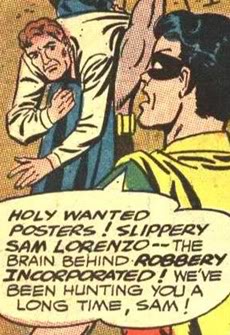
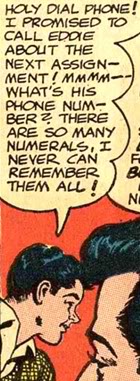
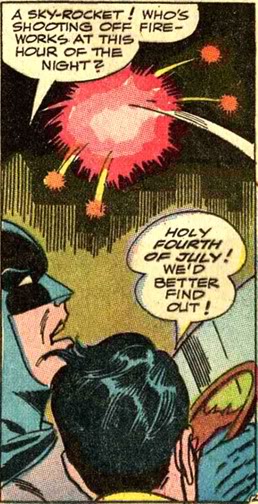
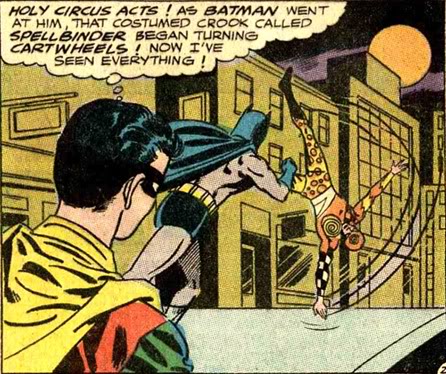
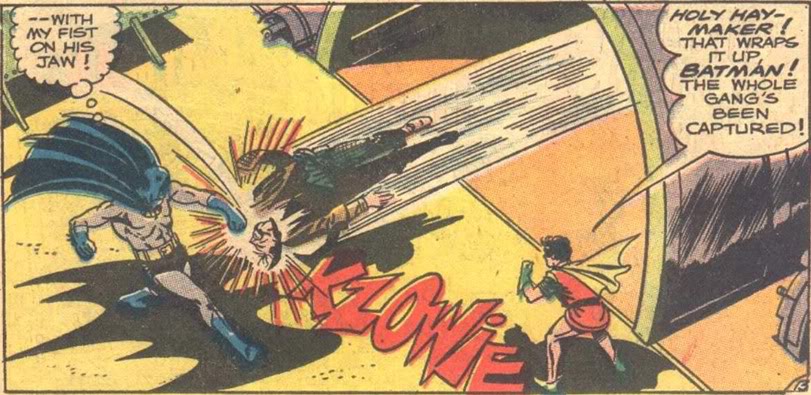
It’s a sad day for any superhero when he starts ripping off his sidekick’s catchphrase.
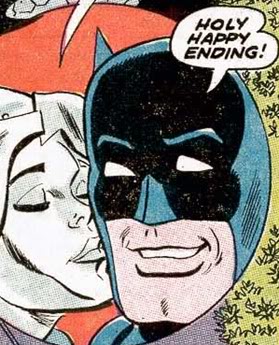
Anyway, onto the movie itself...
The film begins with a man in a raincoat and fedora running around at night. Who is this man? Could this be the detective Detective Comics was named after? Or is this Desmond Doomsday, the omniscient narrator voiced by Batman producer Bill Dozier? Who can say? This title sequence has nothing to do with the rest of the film, so it’s not really important.
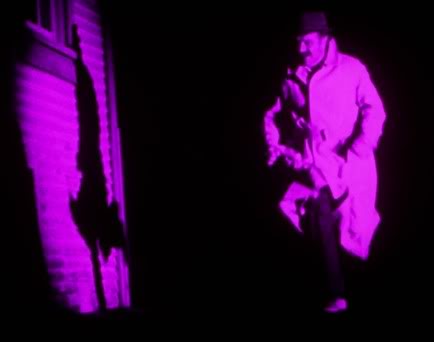
The opening titles end and we are introduced to Bruce Wayne and his young ward, Dick Grayson, as they drive back to stately Wayne Manor. Modern comics tend to depict Wayne Manor as a vast, gothic mansion in a European architectural style. But the Wayne Manor in the early comics was a smaller, more realistic looking abode. Still grand enough to house a rich playboy, but not as exaggeratedly large as in later comics.

As Bruce and Dick pull up outside the house they are greeted by Alfred and Aunt Harriet.
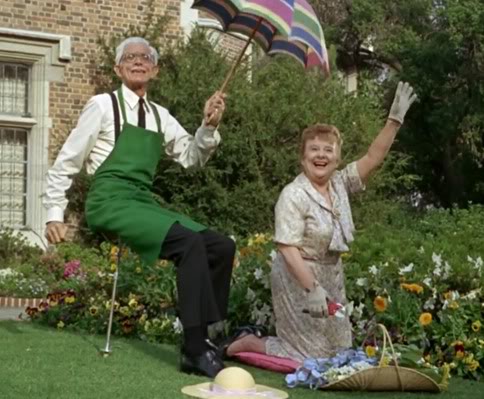
Of course we all know Alfred. Originally called Alfred Beagle, he first appeared in ‘Here Comes Alfred’ (Batman #16, April 1943) and was initially depicted as an overweight butler with a fondness for mystery novels. He discovered the entrance to the Batcave and ended up staying on as Bruce and Dick’s butler. Later it was decided to change his appearance to match that of actor William Austin, who played Alfred in the 1943 Batman serial. So he went from being overweight to the more familiar thin moustachioed butler we know today. The explanation for his change in appearance was given in ‘Accidentally on Purpose’ (Detective Comics#83, January 1944), where Bruce and Dick caught Alfred secretly working out in the Batcave gym. They then sent him on holiday to a health spa, and he returned a few days later looking like a completely different person.
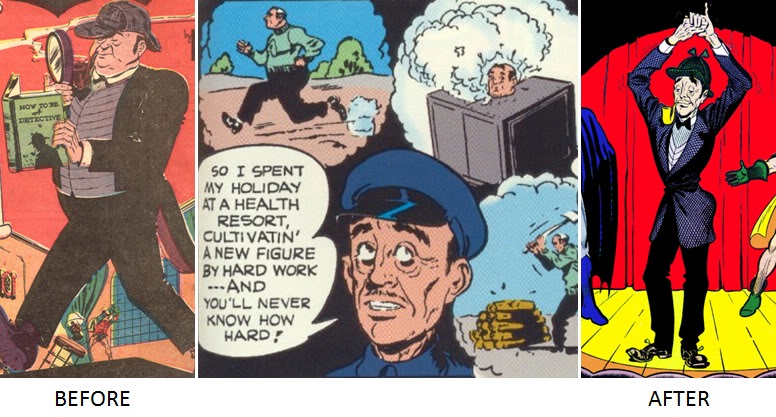
Needless to say the Alan Napier Alfred from this movie is visually modelled on the thinner Alfred.
And then we have Harriet Cooper, Dick Grayson’s aunt, played here by Madge Blake. A common misconception about this character is that she was created for the sixties TV show. In fact she’d already debuted in the comics two years before the show started, first appearing in ‘Gotham Gang Line-Up!’ (Detective Comics #328, June 1964). In this story Alfred was killed saving Batman and Robin, and when news of his death spread Aunt Harriet showed up at Wayne Manor to take care of the boys.
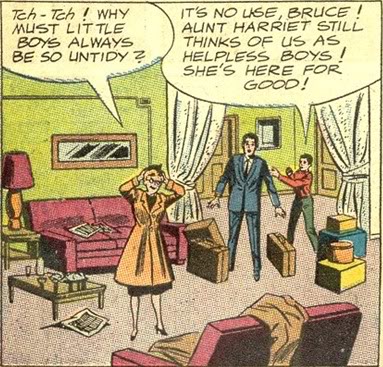
Alfred eventually returned in ‘The Inside Story of the Outsider!’ (Detective Comics #356, October 1966), and from then on both he and Aunt Harriet lived in Wayne Manor with Bruce and Dick. And that’s the set-up we find in this movie.
Bruce and Dick race to the study where they descend into the Batcave via hidden Batpoles. The Batpoles didn't appear prior to the TV show, but they have shown up in later comics.
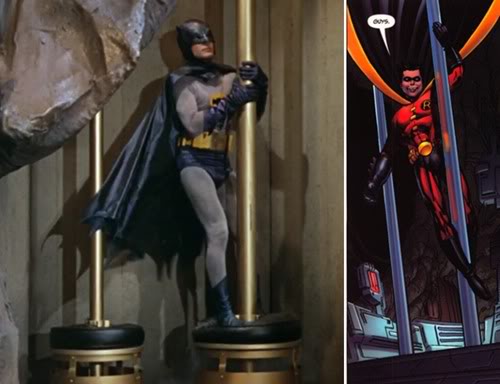
The masked avengers hop into the Batmobile and are on their way. This Batmobile was designed and built by George Barris (who would later go on to build the Red Triangle Gang locomotive used in Tim Burton’s Batman Returns (1992)). The car proved extremely popular and similar designs were soon incorporated into the comics.
Even today, comic artists often include the ’66 Batmobile in their drawings of the Batcave.
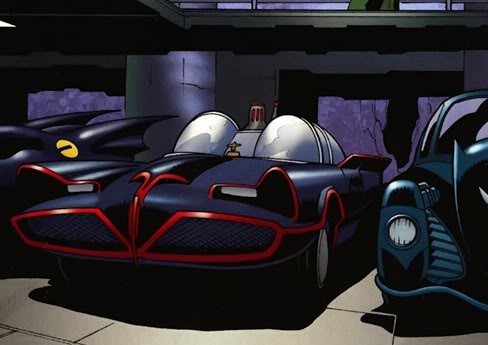
Our heroes drive to an airfield where they board the Batcopter. The evolution of the Batcopter can be seen in several similar vehicles from the comics:
• The Batgyro, which first appeared in ‘Batman Versus the Vampire’ (Detective Comics #31, September 1939)
• The Whirly-Bat, which first appeared in ‘Batman’s Invincible Foe’ (Detective Comics #257, July 1958)
• The Flying Bat-Cave, which first appeared in ‘The Flying Bat-Cave’ (Detective Comics #186, August 1952)

Batman hands over control of the Batcopter to Robin while he climbs down the Bat-ladder. The Robin in the comics was perfectly capable of piloting the Batcopter when similar situations arose. Here’s an example from one of the best New Look-era stories, ‘Death Knocks Three Times!’ (Batman #180, May 1966).
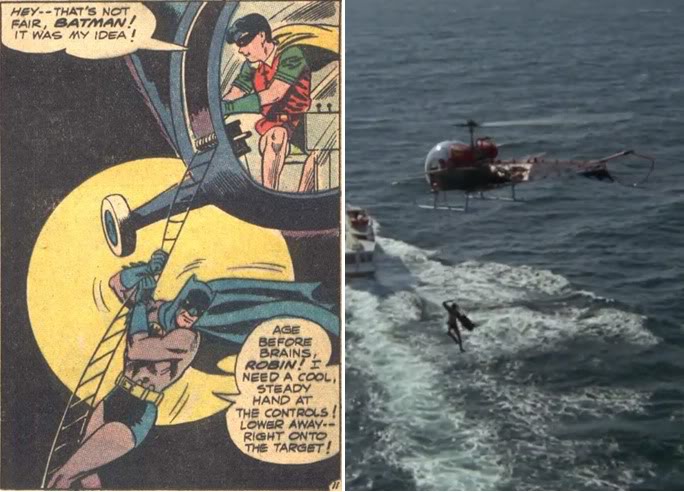
Later in the scene Robin activates the Batcopter’s autopilot while he too descends the Bat-ladder.
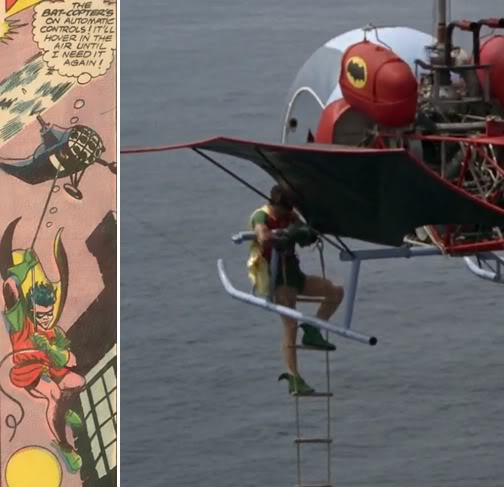
But it turns out the boat is merely a hologram designed to lure Batman into a trap. The Dark Knight finds himself facing off against an exploding shark. The Batman in the comics has found himself in similar predicaments on many occasions.
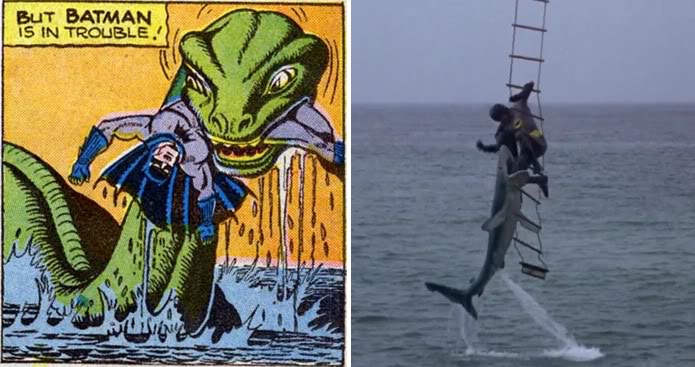
Batman actually has a long history of getting into fistfights with animals in the comics. Representatives of pretty much every creature in the animal kingdom have at some point been punched in the face by the Caped Crusader. Dogs...
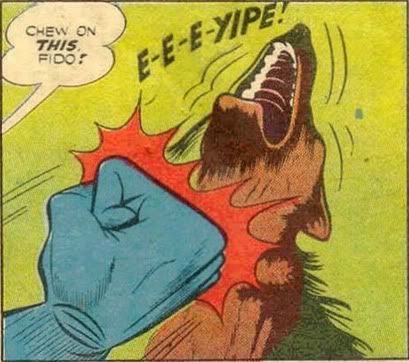
...sabre-tooth tigers...
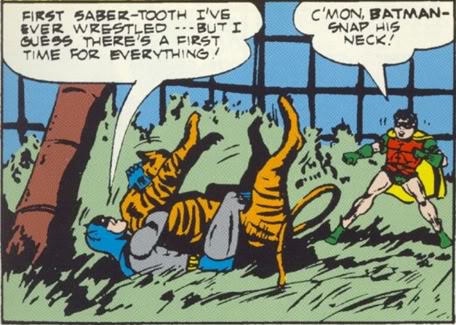
...bulls...
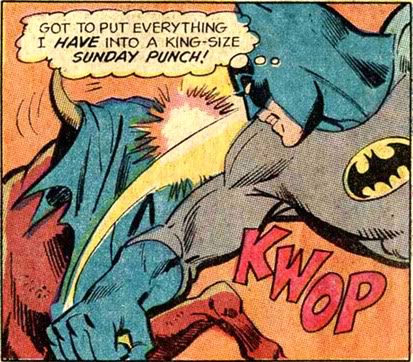
...crocodiles...
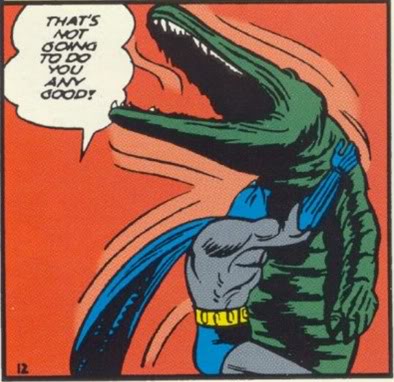
...and of course sharks.

So the scene in the movie is fairly typical of the comics.
Ultimately Batman defeats the shark using shark repellent bat-spray. I can’t offhand recall this being used in the comics before the movie came out, but it’s been jokingly referenced in subsequent stories.
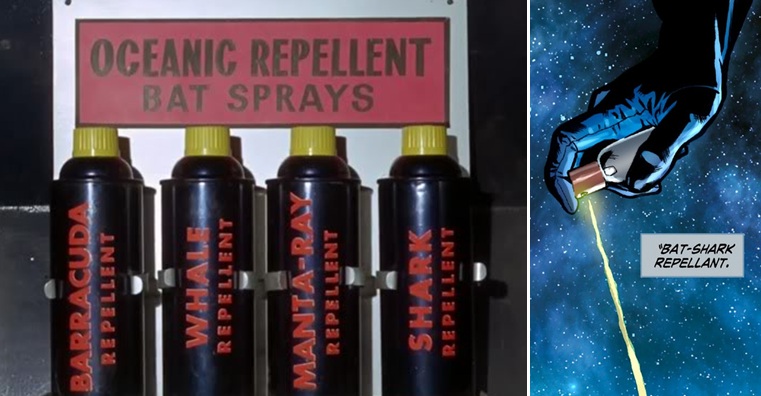
The exact nature of the “trained exploding shark” is never explained in detail. Was it a robot, “an unfortunate animal who chanced to swallow a floating mine”, or something more sinister altogether? We never really find out.
Batman and Robin return to dry land where they attend a press conference held in Commissioner Gordon’s office at police HQ. Gordon’s office regularly housed similar meetings in the comics.

Of course everyone’s already familiar with Commissioner James Gordon. But this isn’t the younger Gordon of the Post-Crisis era, who transferred to Gotham from Chicago and worked his way up the police department hierarchy. In the Pre-Crisis comics Gordon was already a mature police commissioner when he first appeared in ‘The Case of the Chemical Syndicate’ (Detective Comics #27, May 1939). He was usually depicted as a turkey-necked, middle-aged man with glasses and a moustache. Neil Hamilton played him in the movie and TV series. He more or less resembled the comic version, minus the glasses and moustache.
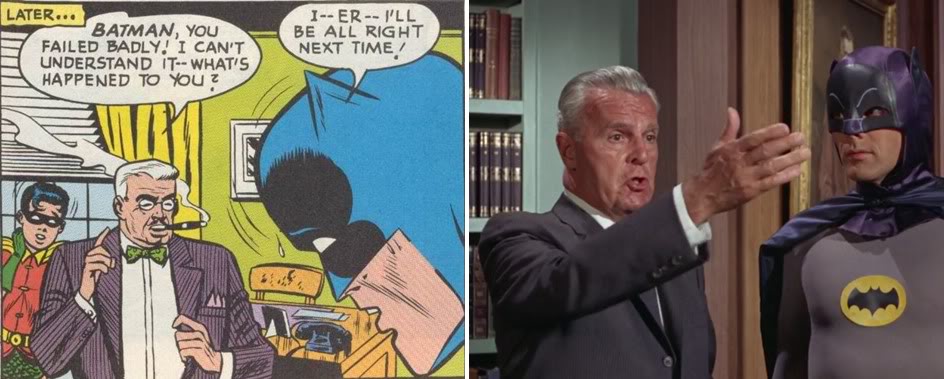
Also present is the GCPD’s finest, Police Chief Miles O’Hara, played by Stafford Repp. O’Hara was created for the television show. He was first referenced in the comics in ‘The Cape and Cowl Crooks’ (World’s Finest Comics #159, August 1966). Note Robin’s "Holy Santa Claus" line and the red Batphone receiver; both nods to the TV show.
Interestingly, there is a Disney character called Chief O’Hara who first appeared in the Mickey Mouse comics in May 1939. He was conceived as a stereotypical Irish cop (like the Batman version) and continues to appear in numerous comic and animated productions to this day. Could the Disney Chief O’Hara have inspired the Batman character?
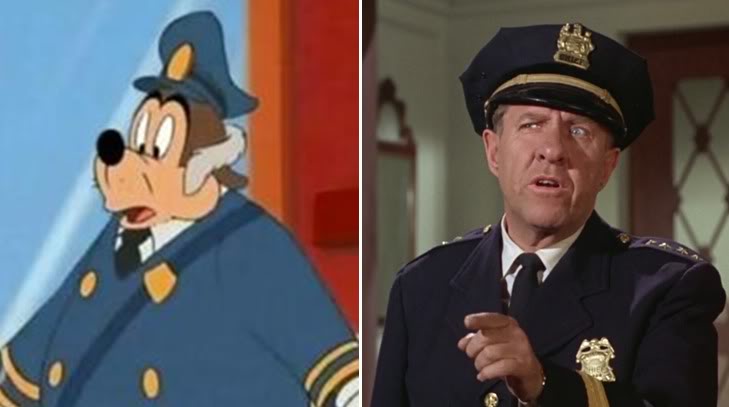
Two of the newspapers represented at the conference are The Gotham City Times and The Globe. These are both Gotham City newspapers from the comics.
During the conference Commissioner Gordon states that Batman and Robin are fully deputised agents of the law. Frank Miller commented on this aspect of the sixties TV show in Legends of the Dark Knight: The History of Batman (2005), saying:
"The worst thing they did on the old TV show was give Batman a badge. You don't deputize Batman."
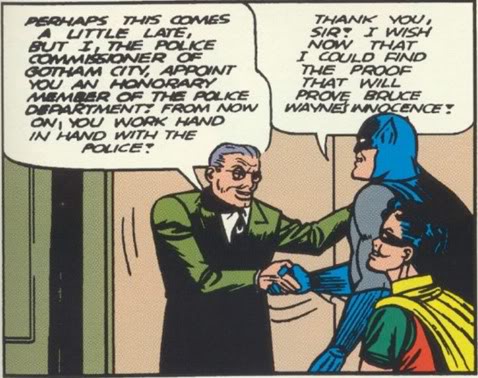
Catwoman had a number of alter egos in the early comics before the name Selina Kyle was introduced. Kitka, however, was not one of them. What’s peculiar about Catwoman’s alter ego here is that Batman doesn’t recognise her. He’s already seen her without her mask on during the TV show. But in the TV show Catwoman was played by Julie Newmar, who was unavailable to shoot the movie. So Lee Meriwether stepped in to replace her. Perhaps this is meant to be a different Catwoman than Newmar’s. Or are we to assume this is the same character, but the movie is a prequel to the TV show and occurs before Batman has seen Catwoman without her mask on? Or is Batman so incredibly dim that he’s thrown by her fake accent? It’s never explained.
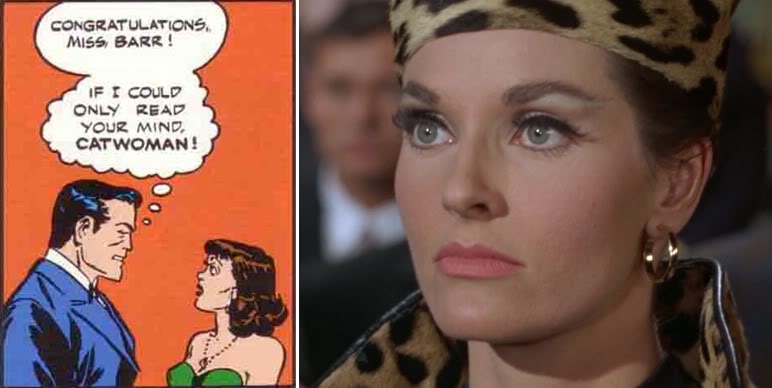
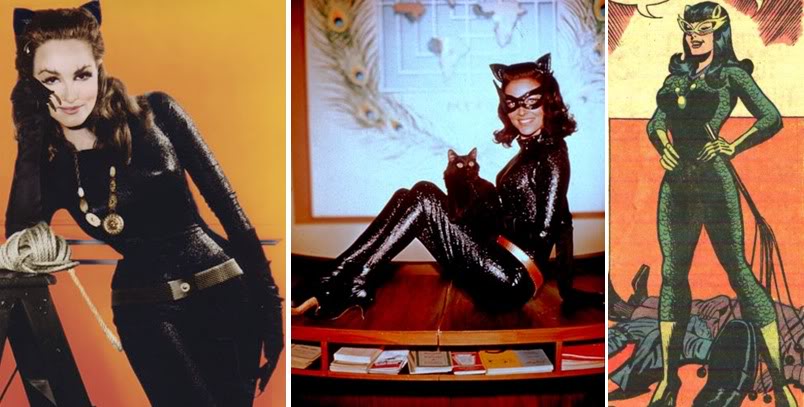
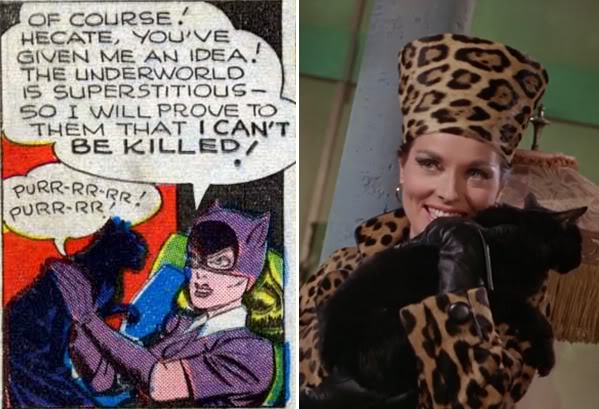
She also has metal claws.
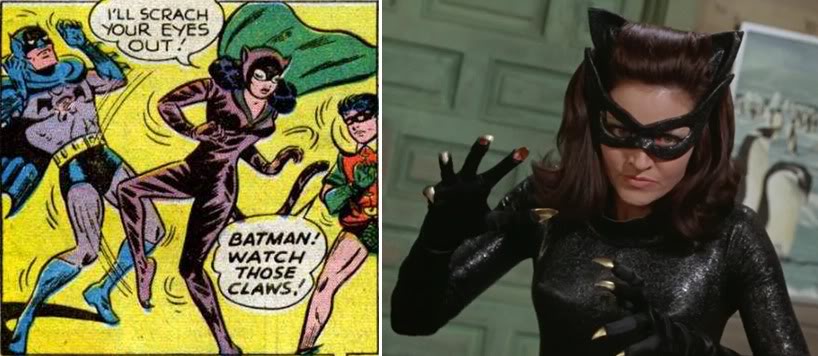
And of course she has her signature weapon: a cat o’ nine tails whip. Nowadays Catwoman usually wields a bullwhip. But in the early comics she invariably used a cat o’ nine tails.
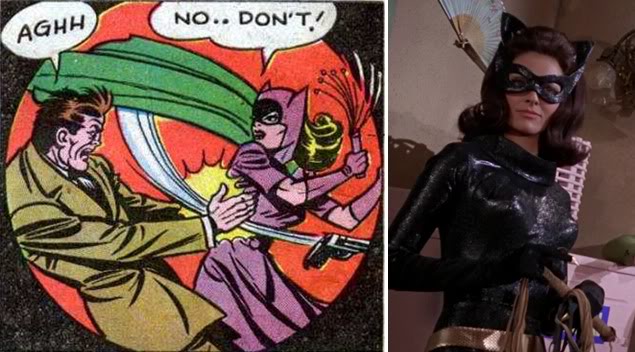
The plotline about Catwoman dating someone as part of a kidnapping scheme is similar to 'The Duped Domestics' (Batman #22, April 1944), in which she masquerades as a woman named Belinda in order to get close to Bruce Wayne's butler, Alfred. She ends up kidnapping Alfred in the comic, mistaking him for Batman. In the movie she helps kidnap Bruce.
The film’s other three villains are Joker, Penguin and Riddler. All three are visually accurate to their comic counterparts. The Riddler actually has two costumes in this movie: the traditional spandex costume from the comics and a new green suit patterned with black question marks. This second outfit was conceived by Riddler actor Frank Gorshin, who disliked wearing the spandex outfit. Variations of the green suit have now superseded the original outfit as the Riddler’s primary costume in the modern comics.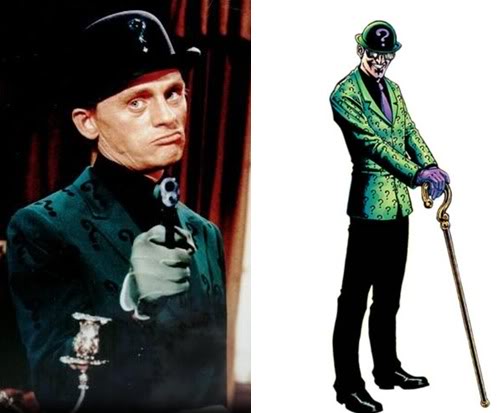
As Penguin and Riddler start bickering, the Joker sneaks up on them and gives them each a jolt from an electric buzzer.
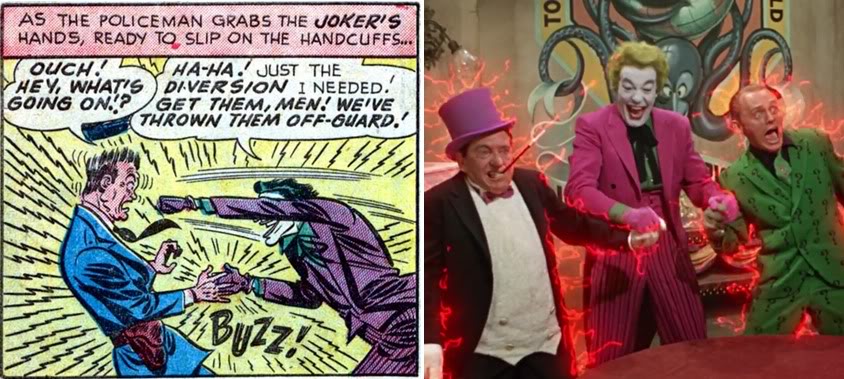
The goons in this story behave and dress according to a Jolly Roger pirate motif. Batman and Robin have gone up against pirates on many occasions, with one of the earliest examples being ‘Blackbeard’s Crew and the Yacht Society’ in Batman #4 (1940).

But the goons in this movie are specifically obedient to the Penguin, making this a likely reference to ‘The Blackbird of Banditry!’ (Batman #43, October 1947). There are several scenes in the movie which seem to reference this story. Early in the comic the Penguin robs a restaurant aboard a ship. He and his goons dress as cutlass-wielding pirates and spout stereotypical pirate phrases.

Back at the Batcave, the Dynamic Duo discover the holographic ship was created by an unregistered buoy out at sea. They race to the harbour and board the Batboat. The first Batboat in the comics was the H. M. S. Boatboat from ‘Batman and Robin in Scotland Yard’ (Detective Comics #110, April 1946). It was a fairly cumbersome vehicle. The design was streamlined over time to make it a sleeker craft like the one in the movie.

When they reach the buoy they fall foul of yet another trap. This time the Penguin incapacitates them using an electromagnet to attract the metallic objects in their utility belts. The Penguin pulled the exact same trick in ‘Partners in Plunder!’ (Batman #169, February 1965). This is certainly a deliberate reference, as Batman: The Movie screenwriter Lorenzo Semple Jr. had previously adapted this comic for the first season episodes ‘Fine Feathered Finks’ & ‘The Penguin’s a Jinx’.
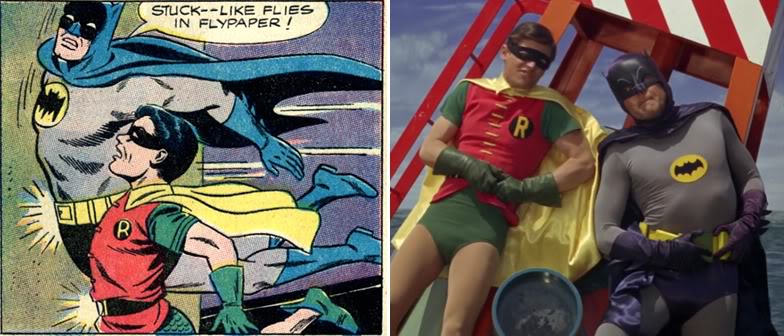
We are then introduced to the Penguin’s vehicle of choice in this film: a pre-atomic submarine shaped like a giant penguin. The Penguin in the comics has had several similarly designed vehicles. Perhaps the most obvious example would be his penguin-shaped blimp, which first appeared in the aforementioned Batman #43 and showed up in several stories throughout the Golden and Silver Age comics. Note the design is remarkably similar to the submarine, complete with lateral penguin wings, a giant beak protruding from the front and flipper feet at the back.
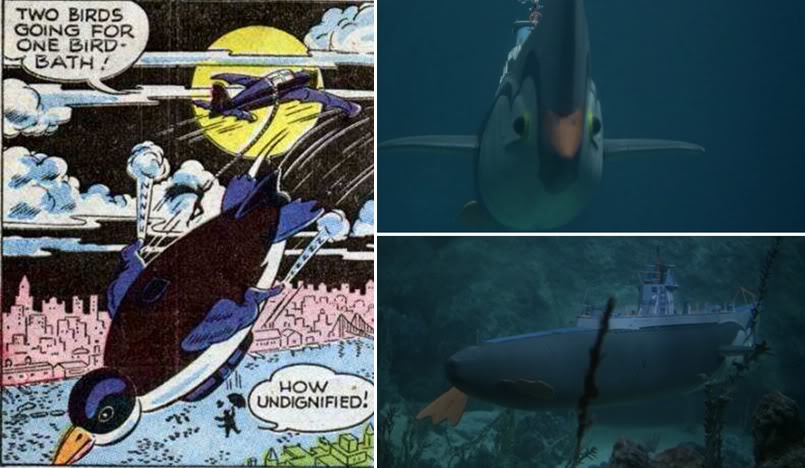
Batman and Robin escape the Penguin’s trap and make it back to dry land. Suddenly a Polaris missile rockets into the sky and writes a message – the Riddler’s latest conundrum. In his first few comic appearances the Riddler relayed his latest puzzles by projecting them onto easily visible locations (the side of a building, a giant blimp, etc).
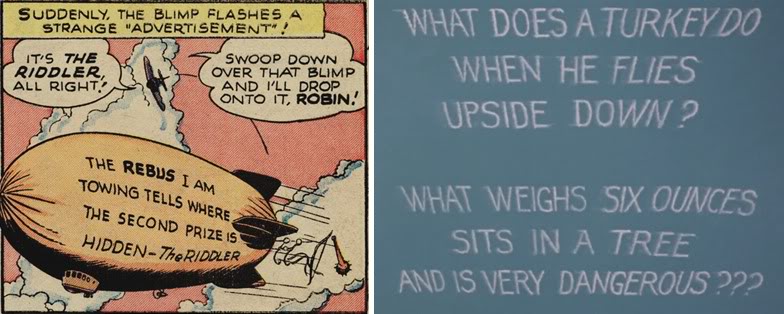
Robin’s ability to solve the riddles and identify the tenuous connections between them is also typical of the comics. Again, note the use of the "Holy" catchphrase.
Through the Riddler’s clues, the Dynamic Duo deduce that Russian journalist Kitka is the villains’ next target. Batman uses his playboy persona as Bruce Wayne to get close to Kitka and take her on a date. The first time Bruce Wayne dated Catwoman’s alter-ego in the comics was ‘Your Face is Your Fortune’ (Batman #15, February 1943). Their date in the movie is pretty similar to the one in the comics. We see them drinking and dancing together. But in the comic Elva is genuinely smitten with Bruce, whereas in the movie Kitka is merely luring him into a trap.

During the date, Robin concocts a plan to draw out the villains. He phones Commissioner Gordon on the Batphone. In the comics, Batman and Gordon had a special hotline by which they could privately communicate. It looked like an ordinary black telephone and was kept in Gordon’s office at police HQ. In later comics its appearance was changed to match the bright red telephone from the TV show and movie.

Robin instructs Gordon to shine the Bat-Signal into the sky, thus making the crooks think Batman is preoccupied and giving them a window of opportunity to strike. We’re all familiar with the Bat-Signal, but here’s its very first appearance from ‘The Case of the Costume-Clad Killers’ (Detective Comics #60, February 1942).
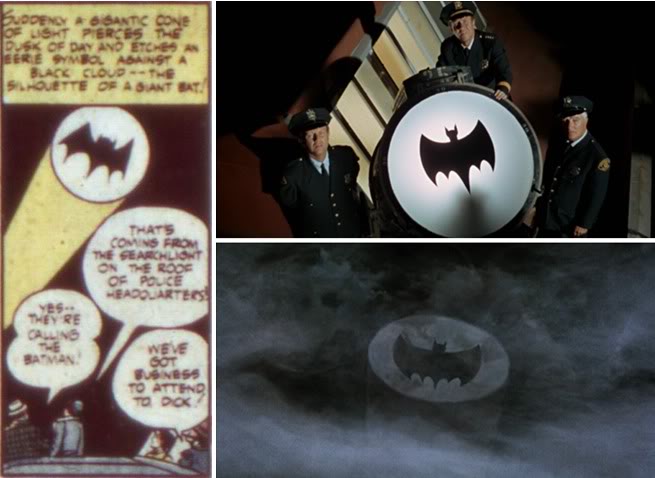
Kitka sees the signal and sends a message to the other villains telling them to strike.
Joker, Riddler and Penguin then set off to kidnap Wayne on flying jet-umbrellas. The jet-umbrellas first appeared in the comics in Batman #169. And as I mentioned earlier, Lorenzo Semple Jr. had already adapted this comic for the TV show. So this would be another conscious reference.
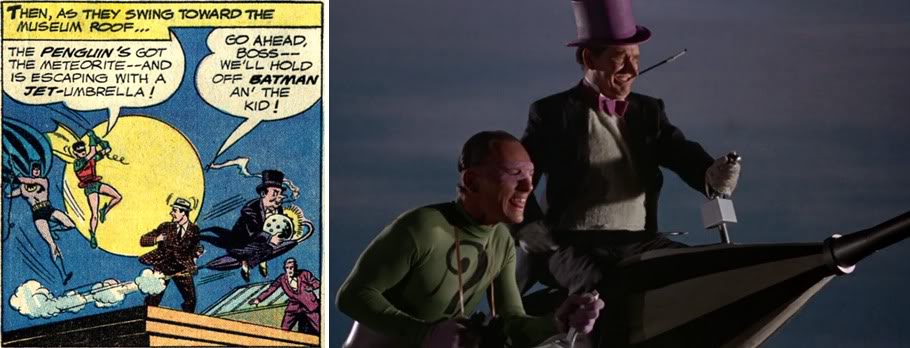
Back in the Batmobile, Robin and Alfred are spying on Bruce and Kitka via the Batmobile’s surveillance system (which is conveniently linked to cameras inside Kitka’s apartment). Robin gets uncomfortable spying on the increasingly intimate date and switches off the monitor. While Burt Ward was in his twenties at the time of filming, the Robin in this movie is meant to be an innocent boy in his mid teens. The Robin in the comics would often look away whenever Batman kissed a girl, and the movie exploits his Boy Scout innocence for comedic effect.
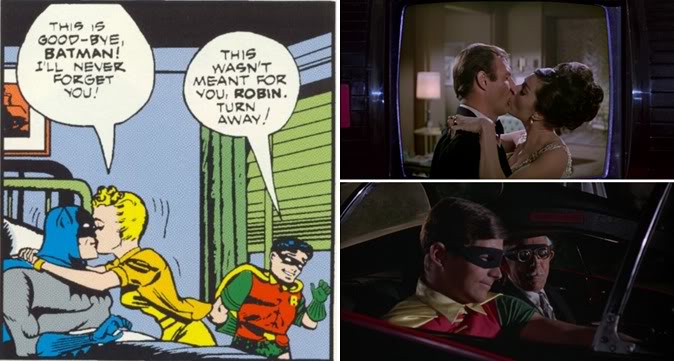
But Robin’s descretion comes at a price, and it’s while he’s not looking that the villains strike; subduing Bruce and kidnapping him on jet-umbrellas. Back at the villains' hideout, the kidnapped Bruce tricks his captors into untying him. He then springs into action, dishing out two-fisted justice against uneven odds. During the skirmish, one of the goons falls foul of the trap they’d set for Batman. First he lands on the Joker’s jack-in-the-box and is catapulted out through the window. The giant jack-in-the-box is one of the Joker’s oldest signature weapons in the comics. It can sometimes be seen on display in the Batcave along with other trophies such as the giant coin and dinosaur.
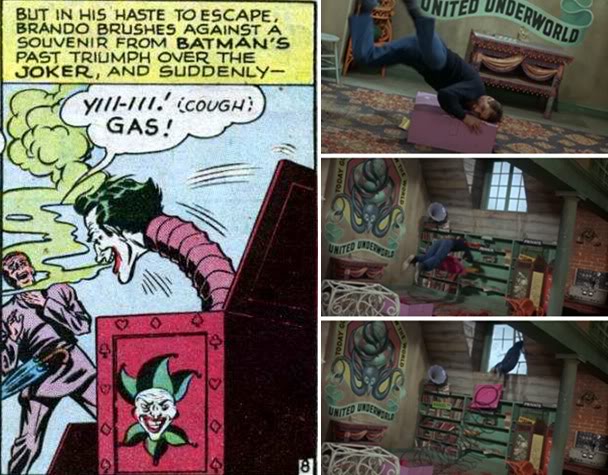
The unfortunate goon is sent flying over the sea before eventually landing in the arms of the Penguin’s exploding octopus. As with the shark, it’s unclear whether this octopus was a real animal the Penguin had somehow trained to spontaneously combust, or else a robot primed with explosives. Either way, both it and the goon are blown to smithereens, marking probably the only time the Cesar Romero Joker ever killed anyone. I can’t offhand recall any exploding octopuses in the comics, but Batman and Robin did stumble into a death-trap involving a giant octopus in ‘The Island of 1,000 Traps’ (Batman #139, April 1961). It didn’t explode though.
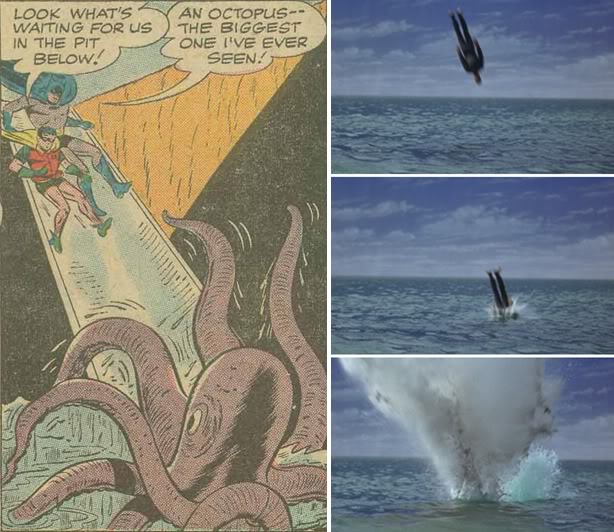
 Bruce escapes from the clutches of the villains and returns to Wayne Manor where he explains to Dick what happened. The two of them quickly change into their costumes and race back to the pier hoping to rescue Kitka. This highlights an important difference between the Batman/Catwoman relationship in this movie and in the comics. Here, Bruce Wayne genuinely doesn’t know the woman he’s dating is really Catwoman. When Bruce dated Elva Barr back in Batman #15, he knew all along that she was Catwoman. This scenario of having Bruce unaware that his beloved is also his enemy would later be used in Batman Returns and Batman: The Animated Series.
Bruce escapes from the clutches of the villains and returns to Wayne Manor where he explains to Dick what happened. The two of them quickly change into their costumes and race back to the pier hoping to rescue Kitka. This highlights an important difference between the Batman/Catwoman relationship in this movie and in the comics. Here, Bruce Wayne genuinely doesn’t know the woman he’s dating is really Catwoman. When Bruce dated Elva Barr back in Batman #15, he knew all along that she was Catwoman. This scenario of having Bruce unaware that his beloved is also his enemy would later be used in Batman Returns and Batman: The Animated Series.
Upon reaching the villains' hideout, Batman and Robin scale the walls using their Bat-ropes. This was long before the advent of the grapple gun, and back then the Dynamic Duo simply threw Batarangs onto rooftops and climbed up the attached ropes.
On the left is an example from ‘Mystery of the Missing Manhunters!’ (Batman #184, September 1966), where Robin deftly hurls a Batarang up what appears to be a ten-story high building – and manages to loop it around a stanchion at the top.
The Batarang itself first appeared in ‘Batman Versus the Vampire’ (Detective Comics #31, September 1939).
Having secured the rope, Batman and Robin then climb up the wall.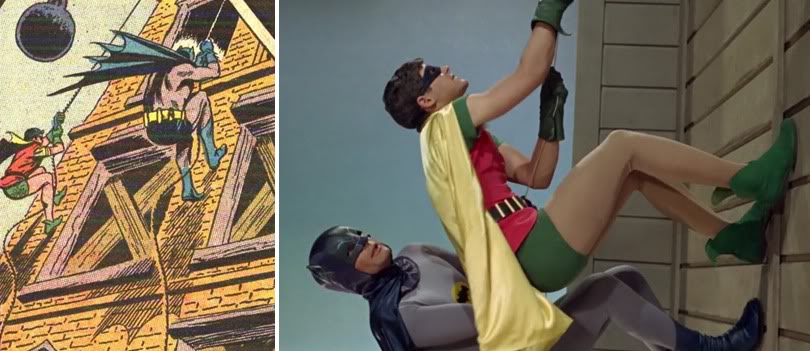
They reach the roof and discover the hideout is abandoned. But the villains have left a bomb behind. Realising it will kill everyone on the pier when it detonates, Batman bravely hoists the bomb above his head and tries to find a safe place to discard it. If you think the image of Batman holding a bomb over his head is ludicrous then you should read ‘Batman Battles the Living Beast-Bomb!’ (Detective Comics #339, May 1965), in which the Caped Crusader had to hold a gorilla strapped with explosives above his head in order to disarm it. It’s as strange as it sounds, and it came out just one year before the movie.
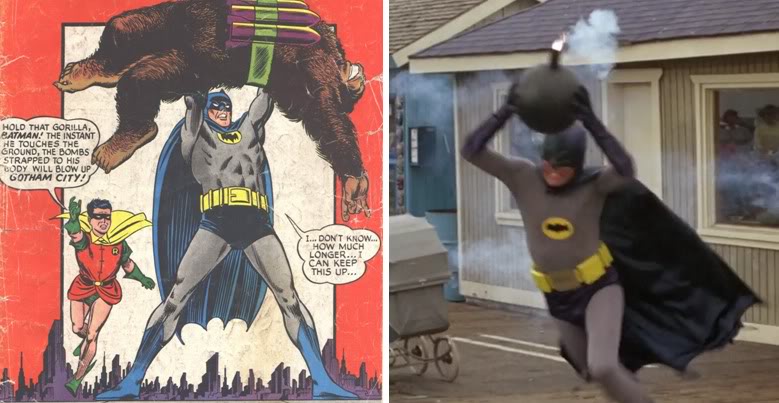
The Dynamic Duo are then approached by a strangely familiar man claiming to be Commodore Schmidlapp. But it’s actually the Penguin, cunningly disguised. They drug the ‘Commodore’ and take him back to the Batcave.
In 1995 comic artist Dick Sprang drew a print depicting the Batcave of the 1950s down to the tiniest detail.
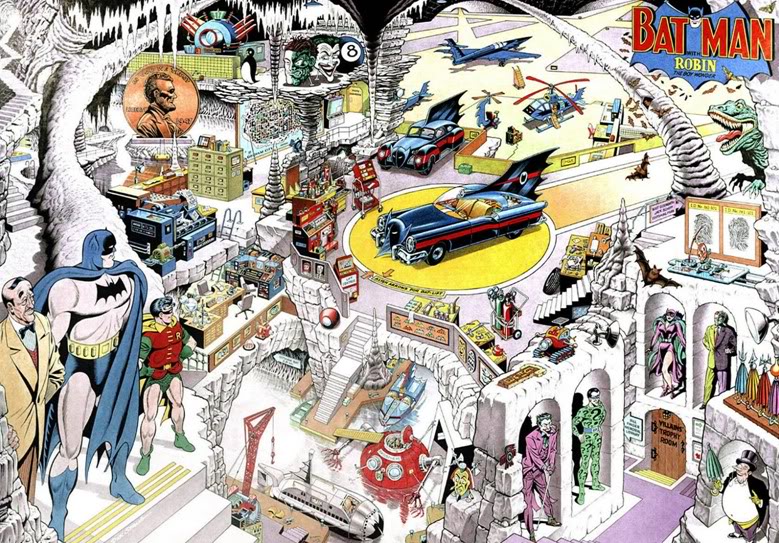
A running gag in the TV show was the way Batman condescendingly labelled all his apparatus with large signs. It’s hard to see in this scaled version of the art, but you can just about spot several similar signs and labels in the comic Batcave. Also note the turntable on which the Batmobile is parked, which was also a feature of the TV show Batcave. And the Batboat in Sprang’s art is clearly modelled on the version from the 1966 movie.
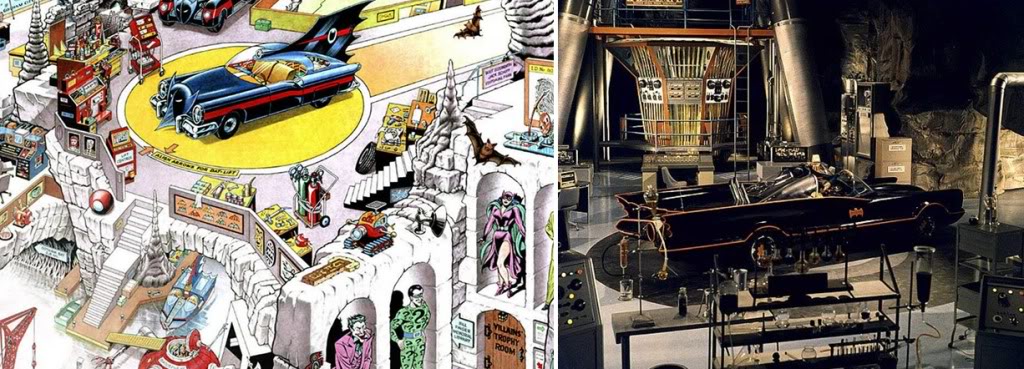
Following a brief skirmish in the Batcave, Batman and Robin drug the disguised Penguin a second time in order to extract him from the cave without compromising its secret location. The instant the Penguin awakes, he knocks Batman and Robin unconscious using knockout gas from his umbrella. The comic Penguin’s umbrella shot knockout gas in his very first story, ‘One of the Most Perfect Frame-Ups’ (Detective Comics #58, December 1941).
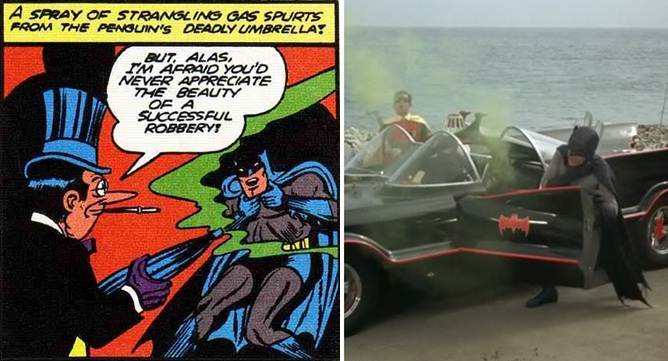
But Batman and Robin were expecting this and had taken the precaution of swallowing antidote tablets beforehand. They then follow the purloined Batmobile on the Batcycle.
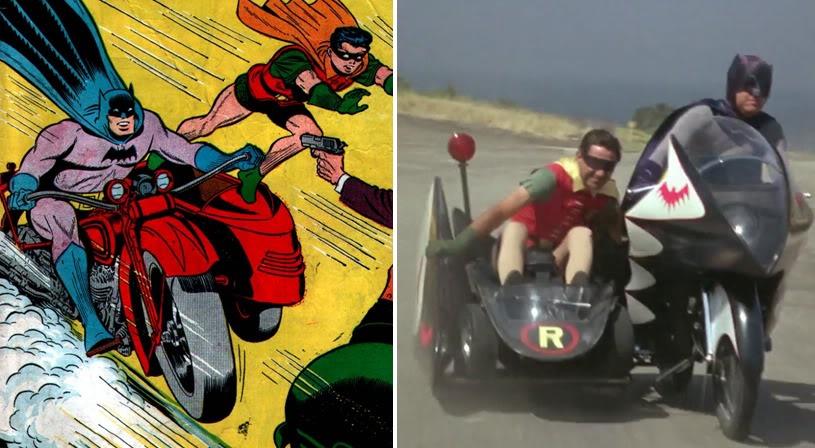
Elsewhere, the four villains execute their scheme to kidnap the nine members of the United World Organisations Security Council. They do this using an advanced dehydration device they’d stolen from the yacht at the beginning of the movie. This aspect of the plot – whereby the villains steal a hi-tech evaporation machine from a ship mid-transit – would later be reused in Christopher Nolan’s Batman Begins (2005).
Batman and Robin give chase, desperate to retrieve the kidnapped Council members and avert a global incident.
They track down the Penguin’s submarine and force it to surface. They then board the submarine and do battle with the villains on deck. This scene visually recalls a similar battle from ‘Tiger Shark’ (Detective Comics #147, May 1949).
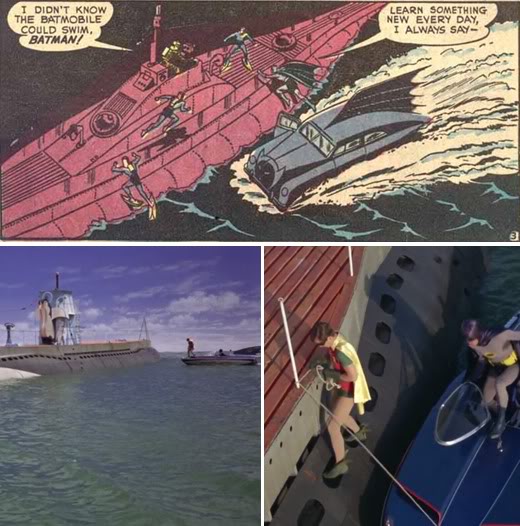
We’re then treated to some onomatopoeic text to punctuate the action. SFX captions have always featured in Batman comics. They became considerably more prominent though once the TV show became a hit.
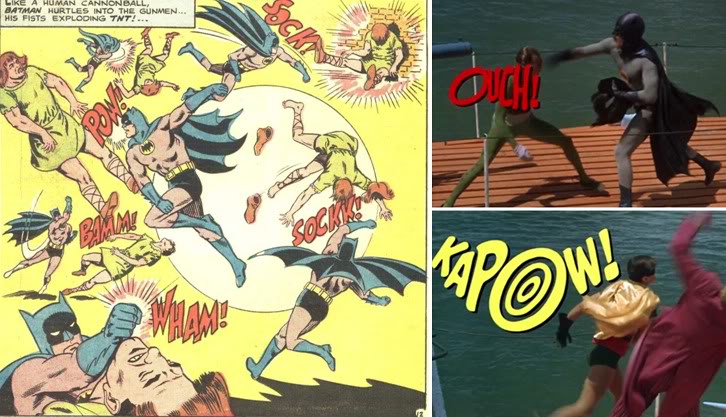
During the fight Batman and Robin execute a tag-team manoeuvre where Batman draws back his fists and Robin pushes them forwards. They used to do team-based moves like this all the time in the TV show. They sometimes did them in the comics too.
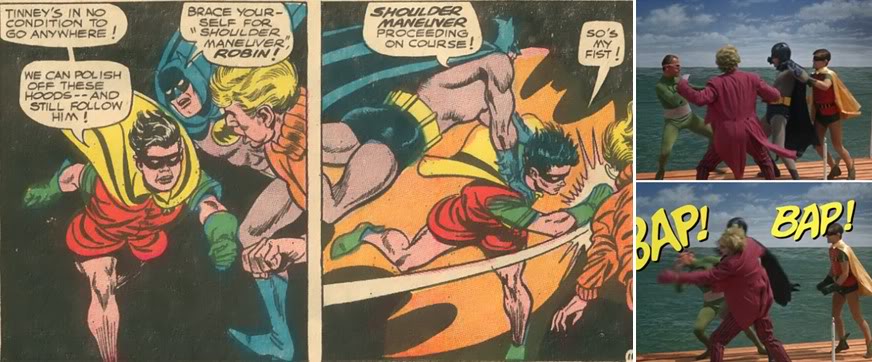
Young viewers accustomed to the more invincible Joker of modern times might take issue with how easily he’s defeated in this film. But the Joker of the fifties and sixties was not an especially skilful combatant and regularly suffered defeat when engaged in hand-to-hand combat. Even the Boy Wonder could regularly kick his backside without breaking a sweat.
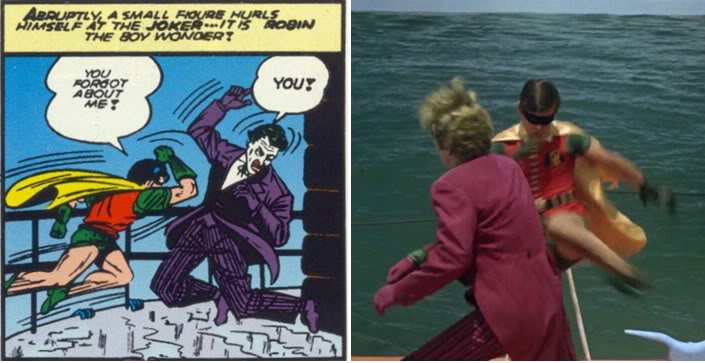
The skirmish culminates in a one-on-one duel between Batman and the Penguin, with the Caped Crusader using a cutlass while his opponent relies on his trusty umbrella. This is yet another element adapted from Batman #43.
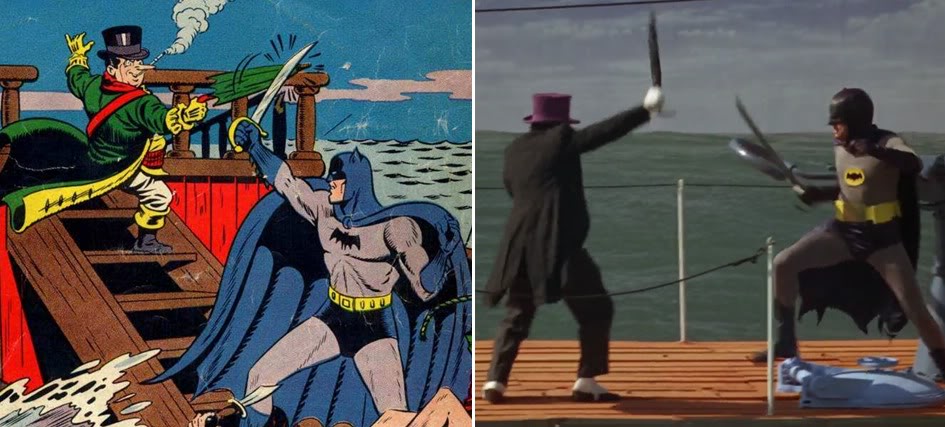
Once all the villains are defeated, Batman unmasks Catwoman and discovers the heartbreaking truth behind her secret identity. He has to arrest her in spite of his feelings for Kitka. It’s an unhappy task the Batman in the comics has done more times than he’d care to remember.
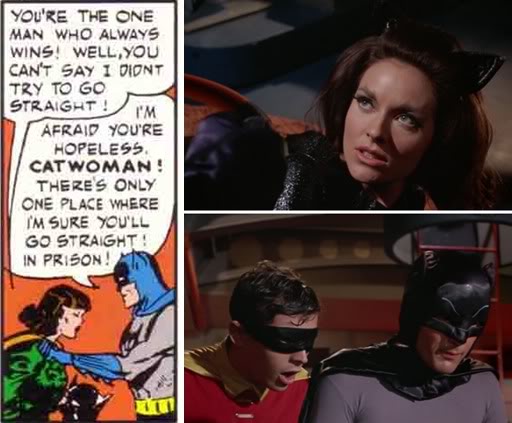
Batman instructs Robin to slap the Bat-cuffs on her. They’re like regular handcuffs, only much, much cooler.
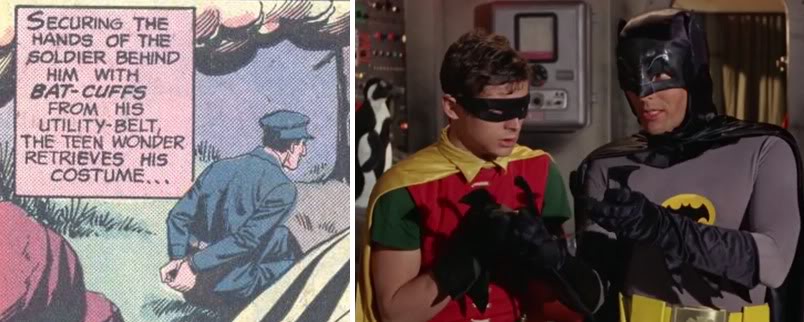
The villains are imprisoned, the delegates are rescued and restored, and our modest heroes leave inconspicuously through the window.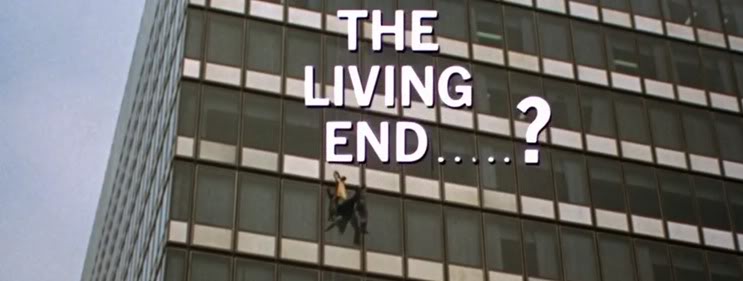
And that concludes this analysis of Batman: The Movie. Discuss this feature in our forum
comments powered by Disqus












by The Joker
by The Joker
by thecolorsblend
by The Joker
by The Joker
by The Dark Knight
by thecolorsblend
by The Joker
by The Laughing Fish
by The Laughing Fish